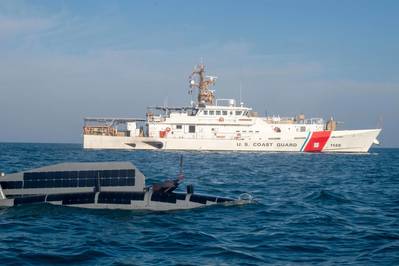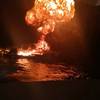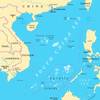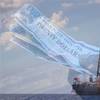The More ‘Eyes On The Water’, The Better
Manama, Bahrain -- Advancing maritime domain awareness in the U.S. Naval Forces Central Command/U.S. Fifth Fleet area of responsibility (AOR) is a challenging task. Yet keeping the sea lanes open is critical for the region, for the U.S. and the world.
U.S. Naval Forces Central Command (NAVCENT), U.S. Fifth Fleet and Combined Maritime Forces (CMF) are all headquartered here in Bahrain, under the command of Vice Admiral Brad Cooper. U.S. Fifth Fleet oversees the operations for all U.S. naval forces in the Middle East. CMF is a 34 member-nation naval partnership dedicated to promoting regional maritime security and stability. Additionally, Cooper leads the International Maritime Security Construct (IMSC), a deterrent force in and around the Strait of Hormuz and Bab al-Mandeb.
There are many ways to keep a watchful eye of the oceans in this dynamic AOR, but there’s no substitute for having eyes on the water.
The U.S. Coast Guard has six Fast Response Cutters (FRC) now assigned to Patrol Forces Southwest Asia, based in Bahrain performing vital patrol and interdiction missions. The 154-foot FRCs have replaced the 110-foot Island class patrol boats that served with PATFORSWA for many years.
According to the Coast Guard Acquisition Directorate’s website, the FRCS are built by Bollinger Shipyards of Lockport, La., and are “designed for multiple missions, including drug and undocumented individuals interdiction; ports, waterways and coastal security; living marine resource protection and enforcement; search and rescue; and national defense. They feature advanced command, control, communications, computers, intelligence, surveillance and reconnaissance equipment; over-the-horizon cutter boat deployment to reach vessels of interest; and improved habitability and seakeeping.”
The Navy had ten 179-foot patrol coastal (PC) ships at Bahrain since the early 2000s, but those ships are being phased out. The reduction of PCs makes the presence of the FRCs even more valuable.
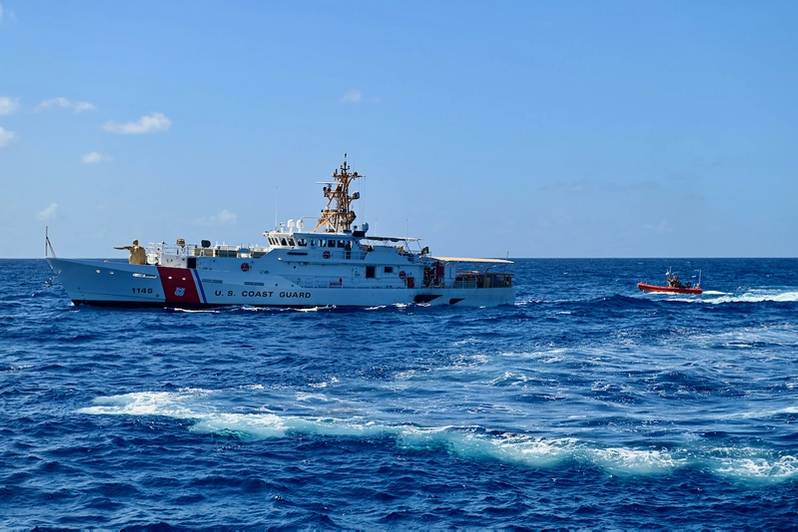 USCGC Emlen Tunnell (WPC 1145) in December 2021 enroute its new homeport in Manama, Bahrain. (Credit: John Hightower / U.S. Coast Guard)
USCGC Emlen Tunnell (WPC 1145) in December 2021 enroute its new homeport in Manama, Bahrain. (Credit: John Hightower / U.S. Coast Guard)
Lt. Patrick Kelly, commands one of the PATFORSWA FRCs, the USCGC Emlen Tunnell (WPC 1145). Because he previously served on a 270-foot medium endurance cutter (MEC), a 110-foot patrol boat and an 87-foot patrol boat, he has a unique perspective and in the differences between legacy ships and the FRC. He has credibility when he says that acknowledges the exceptional capabilities of the FRCs for a relatively small ship.
“While we don’t have the endurance of the larger 270-foot or 210-foot MECs, our operational capabilities are closer to an MEC than the 110s, and our technology—propulsion, weapons, navigation and C2 systems—is newer and better,” Kelly said.
The FRCs can conduct longer and more distant patrols and have greatly improved seakeeping and habitability characteristics. “We can handle the weather better, and can operate with 6- to 8-foot seas, which the 110s would struggle to do,” Kelly said.
Although both the 110s and FRCs have the same five-day endurance, the 110s were usually kept inside of the Arabian Gulf, whereas the FRCs routinely go out into the Arabian Sea and all the way to Pakistan and Djibouti. “The 110s would go out for about a week at a time, whereas the expectation is that we’ll be away for two to three weeks—which means we’ll make port calls in between to take on stores and fuel,” Kelly said.
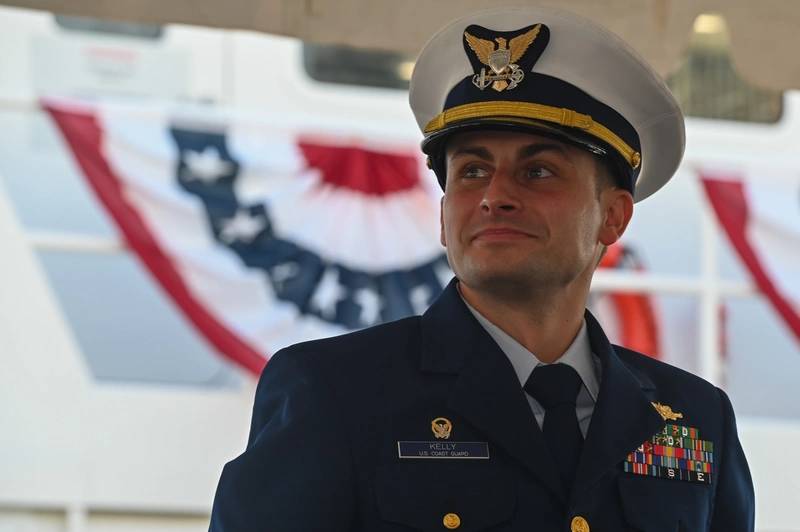 U.S. Coast Guard Lt. Patrick Kelly, the commanding officer of the USCGC Emlen Tunnell (WPC 1145), during the commissioning of the Emlen Tunnell in Philadelphia, October 15, 2021. The Emlen Tunnell is the Coast Guard’s 45th Sentinel-class fast response cutter. (Credit: Breanna Centeno / U.S. Coast Guard)
U.S. Coast Guard Lt. Patrick Kelly, the commanding officer of the USCGC Emlen Tunnell (WPC 1145), during the commissioning of the Emlen Tunnell in Philadelphia, October 15, 2021. The Emlen Tunnell is the Coast Guard’s 45th Sentinel-class fast response cutter. (Credit: Breanna Centeno / U.S. Coast Guard)
Kelly said another major difference between the 110s and the FRCs is the OTH-IV (Over-the-Horizon Boat), which he said is a big improvement over the 110’s cutter boat – medium (CB-M). “Our OTH-IV is bigger, faster and can operate independently for 24 hours.”
The 353-ton FRC has a top speed of 28 knots, a range of 2,500 nm and carries a stabilized 25-mm gun as well as four .50 caliber machine guns.
Cooper has praised the Coast Guard’s Patrol Forces Southwest Asia. “They’re terrific to work with, and frankly, I don't really distinguish between the Navy and Coast Guard.”
Eyes everywhere
In addition to the FRCs and the Navy PCs in Bahrain, there are very capable U.S. and partner nation ships that help patrol the region, but they simply can’t be everywhere all of the time.
Cooper has a vision of establishing a large network of unmanned surface vessels (USV) to serve as a sprawling surveillance net to monitor activity above, on and below the water by using artificial intelligence and machine leaning (AI/ML) to filter out normal activity and alert operators when something appears to be out of place. That vision started in 2021 with the establishment of Task Force 59, which Cooper charged with rapidly integrating unmanned systems and artificial intelligence into fleet operations.
“We believe this technology can enhance our maritime domain awareness by putting more eyes out on the water than we’ve had in the past,” Cooper said. “It’s important to note that we look at unmanned systems and artificial intelligence as being tied together; there's not one without the other.”
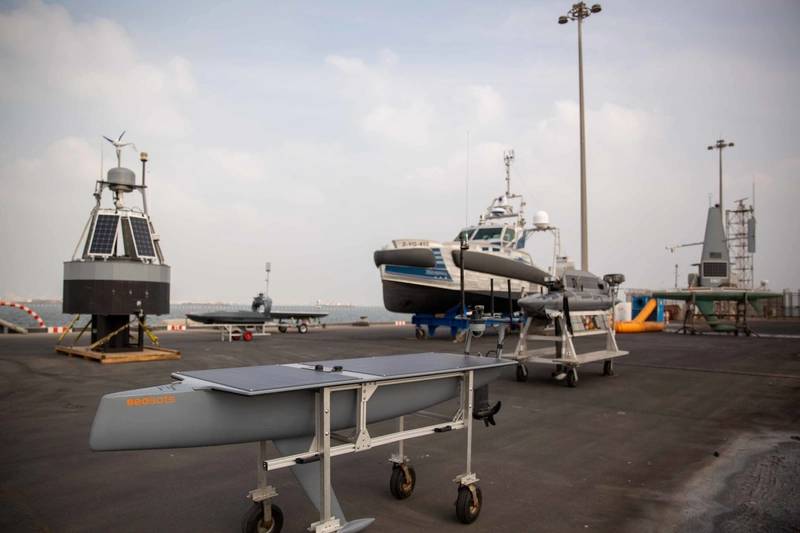 U.S. Coast Guard Lt. Patrick Kelly, the commanding officer of the USCGC Emlen Tunnell (WPC 1145), during the commissioning of the Emlen Tunnell in Philadelphia, October 15, 2021. The Emlen Tunnell is the Coast Guard’s 45th Sentinel-class fast response cutter. (Credit: Breanna Centeno / U.S. Coast Guard)
U.S. Coast Guard Lt. Patrick Kelly, the commanding officer of the USCGC Emlen Tunnell (WPC 1145), during the commissioning of the Emlen Tunnell in Philadelphia, October 15, 2021. The Emlen Tunnell is the Coast Guard’s 45th Sentinel-class fast response cutter. (Credit: Breanna Centeno / U.S. Coast Guard)
The task force works closely with members of Navy’s research and development enterprise, industry, academia and other experts to advance operator feedback in real time to help drive the innovation process forward.
“In the case of the persistent ISR, we have several unmanned vessels underway in regional waters that have been out there for months on end. We currently operate two different types of platforms. One of them provides a persistent ISR capability, and the other has a high-speed sprint capability,” Cooper said.
Iranian ships attempted to capture two of Task Force 59’s Saildrones but was stopped by the U.S. Navy. U.S. officials said that there are no sensitive technologies or extremely valuable equipment on the drones. The USVs utilized are purposefully commercially-available products for this reason.
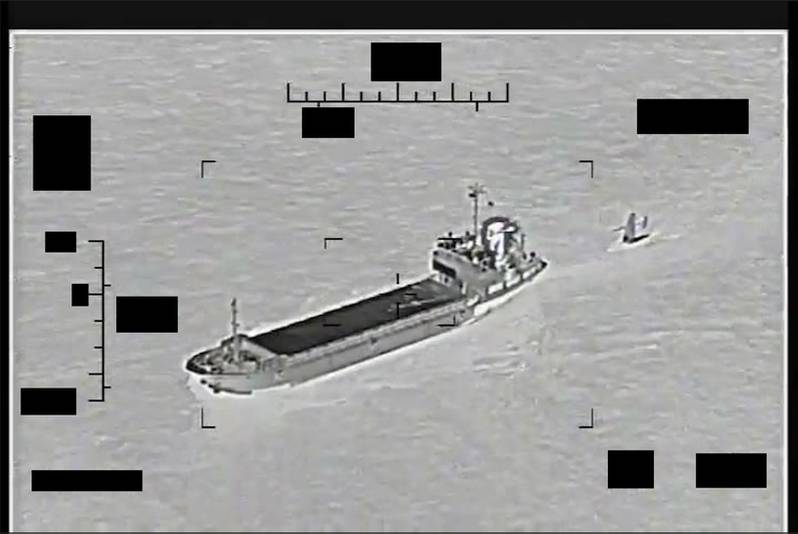 Screenshot of a video showing support ship Shahid Baziar, left, from Iran's Islamic Revolutionary Guard Corps Navy unlawfully towing a Saildrone Explorer unmanned surface vessel in international waters of the Arabian Gulf, August 30. (Credit: U.S. Navy)
Screenshot of a video showing support ship Shahid Baziar, left, from Iran's Islamic Revolutionary Guard Corps Navy unlawfully towing a Saildrone Explorer unmanned surface vessel in international waters of the Arabian Gulf, August 30. (Credit: U.S. Navy)
Task Force 59 has two different types of platforms. “One of them provides a persistent ISR capability, and the other has a high-speed sprint capability,” said Cooper. “In the case of the persistent ISR, we have several unmanned vessels underway in regional waters that have been out there for 140 days, which is incredible. The goal is to work with our partners and grow the USV capability by the end of summer of 2023 to a point where we have 100 USVs operating around the theater. Our partners see the opportunity here and they are very committed to moving forward.”
According to Cooper, Task Force 59 has established operating hubs in Bahrain and Jordan, and it is sending the unmanned surface vessels to sea for long-endurance missions to create and maintain situational awareness and train artificial intelligence. “We want our partners to join us as we add more platforms to increase the coverage and provide that persistent situational awareness,” Cooper said. “The goal is to work with our partners and grow the USV capability to 100 USVs operating around the theater by next year. Our partners see the opportunity here and they are very committed to moving forward.”
Task Force 59 participated in the International Maritime Exercise earlier this year, with 60 nations and international organizations participating. The exercise also included more than 80 unmanned platforms together from 10 of the nations.
Digital Horizon
Most recently, the task force conducted Digital Horizon, an exercise to bring together diverse unmanned platforms and technologies to integrate into a common mesh network that feeds information to Task Force 59’s Robotics Operations Center in Bahrain.
 A Saildrone Explorer participating in the Task Force Digital Horizon exercise is underway near the USCGC Emlen Tunnell (WPC 1145) in the Arabian Gulf near Bahrain on November 30. (Credit: Edward Lundquist)
A Saildrone Explorer participating in the Task Force Digital Horizon exercise is underway near the USCGC Emlen Tunnell (WPC 1145) in the Arabian Gulf near Bahrain on November 30. (Credit: Edward Lundquist)
The USVs taking part in Digital Horizon include Elbit Systems’ Seagull; Exail DriX; L3Harris Arabian Fox and MAST-13; Marine Advanced Robotics WAM-V; MARTAC’s MANTAS T-38 and Devil Ray T-12; Ocean Aero TRITON; Open Ocean Robotics Data Xplorer; Saildrone Explorer; Seasats X3; and SeaTrac SP-48. Unmanned aerial vehicles (UAV) are also participating in Digital Horizon, including two vertical take-off and landing systems, Aerovel’s Flexrotor and Shield AI’s V-BAT, as well as Easy Aerial’s tethered UAV, which is carried in a container on top of one of the USVs. An Ocius USV is also operating off Western Australia and remotely linking into the network.
Each of the vehicles are fitted with a radio communications system from Silvus Technologies to connect the unmanned platforms with the ROC, and then the data is integrated and analyzed with artificial intelligence and machine learning systems from Accenture Federal Services and Big Bear AI.
The artificial intelligence and machine learning component is a critical element of the Task Force 59 efforts to gather and analyze huge amount of data and ascertain which data is part of the normal “pattern of life”, and to alert operators at the ROC when something is acting extraordinary or abnormal.
According to Task Force 59 commander Capt. Michael Brasseur, the task force is managing Digital Horizon in a methodical manner. “For the purposes of our exercise, we’re getting our communications and network established first, and making sure we can receive and present the live video and radar feeds, leverage the machine learning and AI, and integrating all that data into the system. Our goal is to receive data from any sensor and integrate it all on a ‘single pane of glass’ at the ROC.”
 An Aerovel Flexrotor UAV takes off from U.S. Coast Guard fast response cutter USCGC Emlen Tunnell (WPC 1145) transiting the Arabian Gulf, December 7. (Credit: U.S. Navy)
An Aerovel Flexrotor UAV takes off from U.S. Coast Guard fast response cutter USCGC Emlen Tunnell (WPC 1145) transiting the Arabian Gulf, December 7. (Credit: U.S. Navy)
Brasseur said the exercise will begin with daytime operations, and ramp up to 24/7, running a series of vignettes that emulate real-world operations around this region to test how these systems perform and how the data is integrated. “The scenarios will become more challenging and complex as the exercise progresses,” Brasseur said. “We’ll have a better understanding of the limitations of the sensors and the communications, as well as the power of the machine learning and AI to make sense of all the data.”
As part of the exercise, Task Force 59 operated a Aerovel Flexrotor UAV from USCGC Emlen Tunnell, marking the first time a Coast Guard cutter has been integrated into Task Force 59 operations.
Brasseur acknowledged that the goals set forth for Digital Horizon and Task Force 59 are not easy to accomplish with the different platforms and technologies, particularly in the challenging operating environment of the Arabian Gulf. But, he said, the pace of innovation is amazing. “We are challenging our industry partners in one of the most difficult operational environments, and they are responding with enhanced capability, fast.”
“We expect to continue expanding these efforts, with our partners leading the way,” Cooper said. “If we can operate USVs in this environment, given the ruggedness of it and just the landscape, they can probably operate anywhere. I can tell you that the Navy is watching our efforts very closely.”
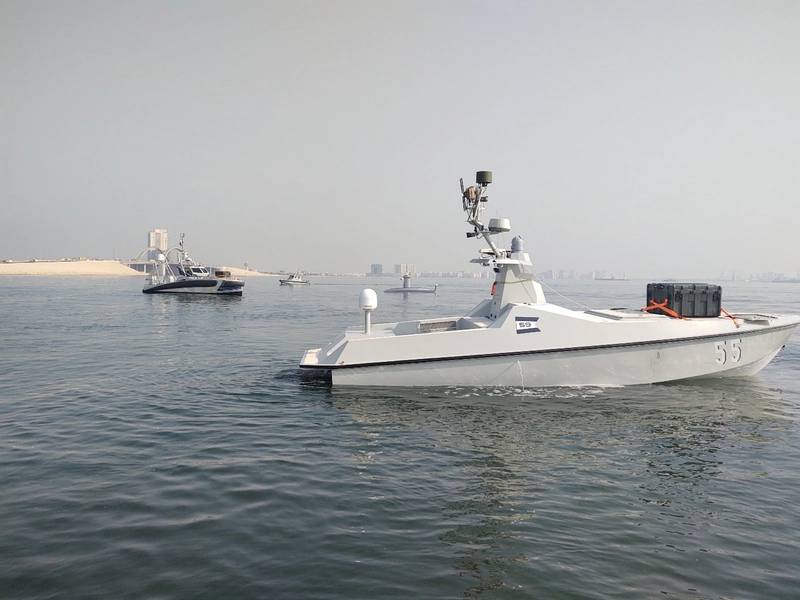 Some of the unmanned systems participating in Digital Horizon 2022 heading to sea from the Naval Support Activity in Bahrain on December 1. (Credit: Edward Lundquist)
Some of the unmanned systems participating in Digital Horizon 2022 heading to sea from the Naval Support Activity in Bahrain on December 1. (Credit: Edward Lundquist)
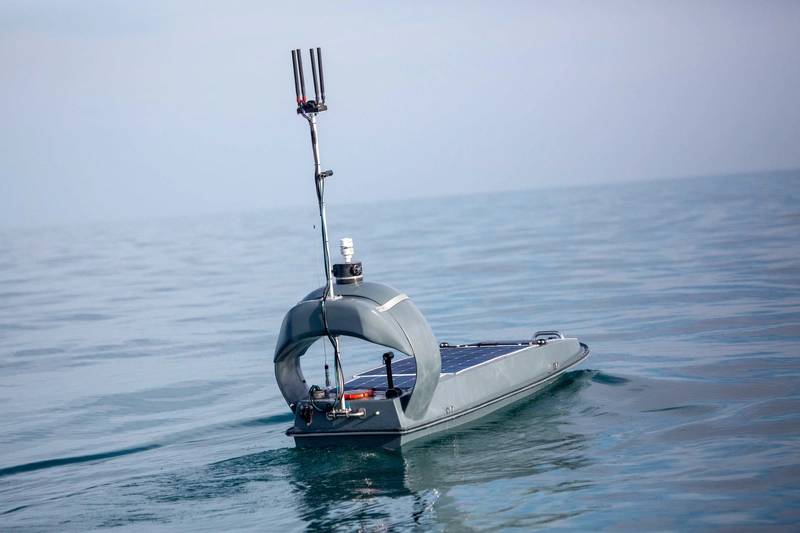 An Open Ocean Robotics Data Xplorer unmanned surface vessel operates in the Arabian Gulf, November 29, during Digital Horizon 2022. (Credit: Brandon Murphy / U.S. Army)
An Open Ocean Robotics Data Xplorer unmanned surface vessel operates in the Arabian Gulf, November 29, during Digital Horizon 2022. (Credit: Brandon Murphy / U.S. Army)
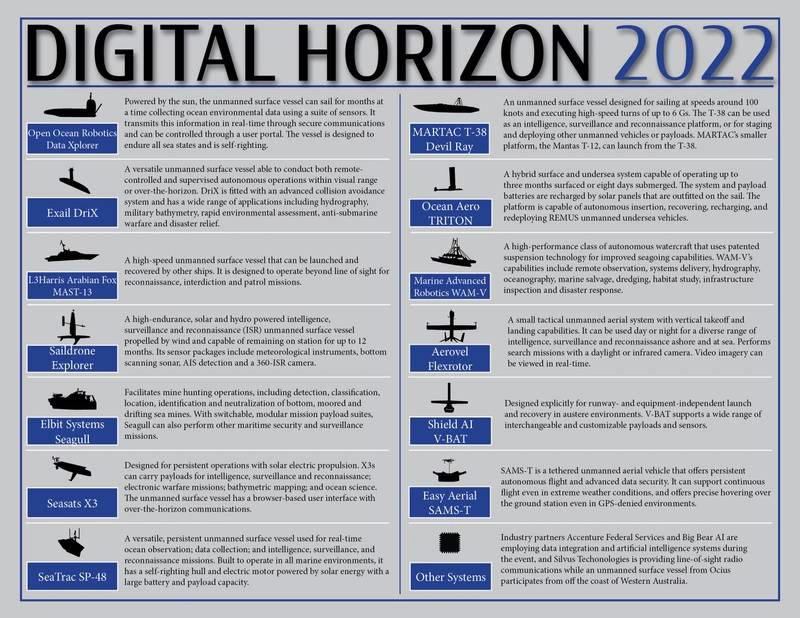 Graphic illustration depicting the unmanned systems that participated in exercise Digital Horizon. (Credit: Brandon Murphy / U.S. Army)
Graphic illustration depicting the unmanned systems that participated in exercise Digital Horizon. (Credit: Brandon Murphy / U.S. Army)




